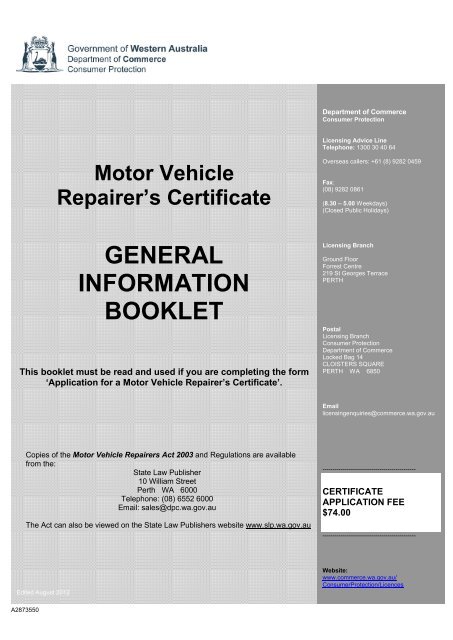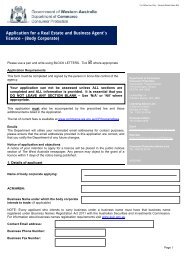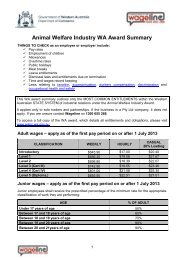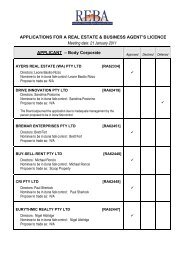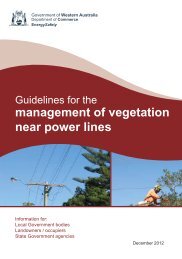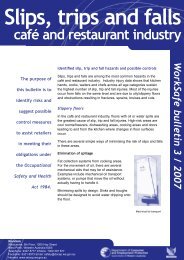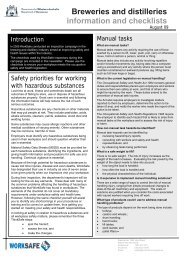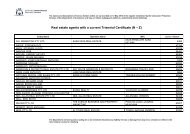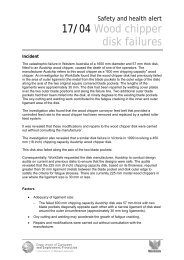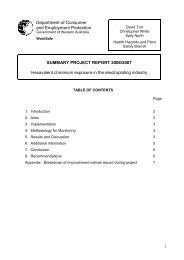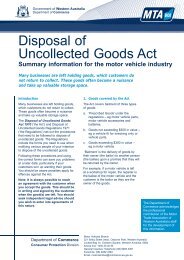Motor vehicle repairer's certificate - information booklet
Motor vehicle repairer's certificate - information booklet
Motor vehicle repairer's certificate - information booklet
You also want an ePaper? Increase the reach of your titles
YUMPU automatically turns print PDFs into web optimized ePapers that Google loves.
A2873550<br />
<strong>Motor</strong> Vehicle<br />
Repairer’s Certificate<br />
GENERAL<br />
INFORMATION<br />
BOOKLET<br />
This <strong>booklet</strong> must be read and used if you are completing the form<br />
‘Application for a <strong>Motor</strong> Vehicle Repairer’s Certificate’.<br />
Copies of the <strong>Motor</strong> Vehicle Repairers Act 2003 and Regulations are available<br />
from the:<br />
State Law Publisher<br />
10 William Street<br />
Perth WA 6000<br />
Telephone: (08) 6552 6000<br />
Email: sales@dpc.wa.gov.au<br />
The Act can also be viewed on the State Law Publishers website www.slp.wa.gov.au.<br />
Edited August 2012<br />
Department of Commerce<br />
Consumer Protection<br />
Licensing Advice Line<br />
Telephone: 1300 30 40 64<br />
Overseas callers: +61 (8) 9282 0459<br />
Fax:<br />
(08) 9282 0861<br />
(8.30 – 5.00 Weekdays)<br />
(Closed Public Holidays)<br />
Licensing Branch<br />
Ground Floor<br />
Forrest Centre<br />
219 St Georges Terrace<br />
PERTH<br />
Postal<br />
Licensing Branch<br />
Consumer Protection<br />
Department of Commerce<br />
Locked Bag 14<br />
CLOISTERS SQUARE<br />
PERTH WA 6850<br />
Email<br />
licensingenquiries@commerce.wa.gov.au<br />
----------------------------------------------<br />
CERTIFICATE<br />
APPLICATION FEE<br />
$74.00<br />
----------------------------------------------<br />
Website:<br />
www.commerce.wa.gov.au/<br />
ConsumerProtection/Licences
1. WHO NEEDS A REPAIRER’S CERTIFICATE?<br />
You will require a repairer’s <strong>certificate</strong> if you:<br />
Last edited 16 August 2012 2<br />
<strong>Motor</strong> Vehicle Repairers Certificate – General Information Booklet<br />
DO REPAIR WORK UNSUPERVISED; or<br />
are an owner of a repair business and you do repair work or supervise the repair work of others; or<br />
are an individual who supervises the repair work of others; or<br />
are an individual repairer and your supervisor does not have a <strong>certificate</strong> for the same class of repair<br />
work that you do.<br />
As a certified repairer you can only supervise repair work for the particular class of repairs that your<br />
repairer’s <strong>certificate</strong> authorises you to perform. You can however apply for more than one class of repair<br />
work if you hold the appropriate qualifications. All permitted classes of repair work will be endorsed on<br />
your <strong>certificate</strong>.<br />
2. NATIONAL POLICE CERTIFICATE<br />
The <strong>Motor</strong> Vehicle Repairers Act 2003 requires that you are a ‘fit person’ to hold a repairer’s <strong>certificate</strong>.<br />
All applicants are required to submit an original or certified copy of a National Police Certificate. The<br />
Certificate must be no more than three (3) months old at the time of lodging the application.<br />
Applications for a National Police Certificate can be made at participating Australia Post outlets in<br />
Western Australia upon provision of identification and payment of a fee. Further <strong>information</strong> is available<br />
from the WA Police by visiting www.police.wa.gov.au.<br />
If you reside outside of Western Australia please contact your local police station or visit the Australian<br />
Federal Police website at www.afp.gov.au.<br />
If you have not lived in Australia continuously for the last three (3) years you will require both the<br />
equivalent clearance from the country in which you previously lived and the National Police Certificate.<br />
You must also provide a copy of the personal details page of your passport.<br />
If a police clearance from your previous country of residence was required to obtain a visa to enter<br />
Australia, a request for a certified copy of that clearance can be made to the Department of Immigration<br />
and Citizenship under the provisions of Freedom of Information (FOI) legislation. To lodge a FOI<br />
application you should contact the<br />
Department of Immigration and Citizenship.<br />
Ground Floor, 836 Wellington Street, West Perth. Telephone: 131 881<br />
Website: www.immi.gov.au.<br />
3. QUALIFICATIONS AND EXPERIENCE<br />
You must be sufficiently qualified to carry out each class of repair work for which you are applying.<br />
A ‘points system’ is used to determine a person’s qualification for a class of repair. You will need at least<br />
100 points to qualify for each class of repair work you are seeking.<br />
A combination of things will be considered for you to be able to reach 100 points. Some of these are:<br />
a relevant formal qualification and/or trade <strong>certificate</strong> (completed apprenticeship) including<br />
those awarded by other States and Territories;<br />
any relevant and recent motor <strong>vehicle</strong> repair work experience;<br />
current membership of a relevant professional industry body;<br />
references about your ability and experience from your employer(s) or customers;<br />
a certification test conducted by a Registered Training Organisation approved by the<br />
Commissioner; and/or<br />
an Australian Recognised Trade Certificate, which is issued after an overseas qualification has<br />
been assessed.
Last edited 16 August 2012 3<br />
<strong>Motor</strong> Vehicle Repairers Certificate – General Information Booklet<br />
You may be eligible for the grant of a <strong>certificate</strong> based on experience, even if you do not have a formal<br />
qualification. Refer to the ‘points system’ below at section 4 for other methods of satisfying the<br />
qualification requirements.<br />
You need to provide copies of all relevant evidence supporting your qualification/s.<br />
If you or your employer believe that you are capable of obtaining sufficient qualifications but are currently<br />
unable to satisfy the qualifications requirement for the grant of a Repairer’s Certificate, you can still<br />
apply. If appropriate, a provisional <strong>certificate</strong> may be issued for a fixed period.<br />
Provisional <strong>certificate</strong>s will be considered only where a person has extensive experience or has nearly<br />
finished a trade qualification. As an example, a provisional <strong>certificate</strong> may be issued to an apprentice<br />
when three years of the four year apprenticeship have been completed.<br />
4. POINTS SYSTEM FOR CERTIFICATION – 100 POINTS REQUIRED<br />
Any combination of qualifications, experience, relevant membership association, references and skills<br />
competence assessments can be used to achieve the 100 point threshold. For full details please refer<br />
to the explanation in section 5 against the corresponding letter below.<br />
Qualification methods<br />
Maximum points available<br />
Certificate II Certificate III<br />
Formal Australian training (or equivalent) – see A below 100 points 100 points<br />
Industry professional membership – see B below 20 points 25 points<br />
Years of experience (per year) – see C below 25 points 10 points<br />
Business references – customer (2 points each) – see D below 10 points 10 points<br />
Business references – non commercial (5 points each)<br />
20 points 20 points<br />
Certification test – see E below 75 points 80 points<br />
Overseas qualification – see F below 80 points 80 points<br />
Overseas experience – see G below 80 points 80 points<br />
The available points outlined above are the maximum points allocated to each type of<br />
qualification method. For full details please refer to the relevant section/s below.<br />
5. QUALIFICATION METHODS<br />
A. FORMAL AUSTRALIAN TRAINING<br />
(See also ‘F. OVERSEAS QUALIFICATIONS’)<br />
Formal qualifications can be gained by completing an apprenticeship or other relevant training, through a<br />
Registered Training Organisation (RTO) e.g. Institute of Technology (TAFE).<br />
If you completed an Australian apprenticeship prior to 1999, you would have received a Trade Certificate in<br />
the trade you completed e.g. “Trade Certificate in <strong>Motor</strong> Mechanics”. You may have also been issued a<br />
Certificate of Trade Studies for completing the theory component of your apprenticeship e.g. “Certificate of<br />
Trade Studies Automotive Mechanical”.<br />
If you completed an Australian apprenticeship after 1999, you would have received a Trade Certificate in the<br />
trade you completed e.g. “Trade Certificate in Panel Beating”. You would also have been issued a Certificate III<br />
of Trade Studies for completing the theory component of your apprenticeship e.g. “Certificate III of Trade<br />
Studies Panel Beating”.<br />
Over the years the names of the <strong>certificate</strong>s have changed, so if the type of <strong>certificate</strong> you hold does not match<br />
the current <strong>certificate</strong> issued by the RTO that does not mean your <strong>certificate</strong> cannot be considered.<br />
If you have lost your Western Australian trade <strong>certificate</strong> you may be able to obtain an “Extract of<br />
Apprenticeship Record”. To do so contact the Apprenticentre on 13 19 54.<br />
If you hold a relevant Australian recognised qualification (Certificate II or Certificate III) or a Trade<br />
Certificate for the class of repair work that you are applying for, you automatically qualify for<br />
certification (100 points) for that class of repair work.
Last edited 16 August 2012 4<br />
<strong>Motor</strong> Vehicle Repairers Certificate – General Information Booklet<br />
B. INDUSTRY PROFESSIONAL MEMBERSHIP BODY<br />
To qualify for points, a membership must be current and must have been held for at least 24 months.<br />
Only one membership can be used towards the accumulation of points.<br />
Member or Associate Member of the Institute of Automotive Mechanical Engineers (IAME)<br />
Associate member or higher of the Society of Automotive Engineers (SAE)<br />
You may receive up to 25 points for a class of repair work that requires a relevant Certificate II.<br />
You may receive up to 20 points for a class of repair work that requires a relevant Certificate III.<br />
C. YEARS OF EXPERIENCE<br />
(See also ‘G. OVERSEAS EXPERIENCE’)<br />
The years of experience you gained working in the motor <strong>vehicle</strong> repair industry within Australia will be<br />
considered when your application for a <strong>certificate</strong> is assessed.<br />
You may receive 25 points for every year of full time employment, for a class of repair work that requires a<br />
relevant Certificate II.<br />
You may receive 10 points for every year of full time employment, for a class of repair work that requires a<br />
relevant Certificate III.<br />
Relevant experience in each class of repair work must be recent and gained in the years immediately prior to<br />
the date of application as follows:<br />
Years of experience: Points for Certificate II : Points for Certificate III :<br />
1 out of previous 2 years 25 10<br />
2 out of previous 4 years 50 20<br />
3 out of previous 5 years 75 30<br />
4 out of previous 6 years 100 40<br />
5 out of previous 7 years 100 50<br />
6 out of previous 8 years 100 60<br />
7 out of previous 9 years 100 70<br />
8 out of previous 10 years 100 80<br />
9 out of previous 11 years 100 90<br />
10 out of previous 12 years 100 100<br />
A job description statement or a statement of service from your employer(s) indicating experience in the<br />
applicable class(es) of repair work is required. If you are self-employed, please provide invoices that<br />
show relevant experience in the class(es) of repair work for which you are applying.<br />
To qualify for either tyre fitting class you are only required to show two years full time experience.<br />
D. BUSINESS REFERENCES<br />
You may receive the following points depending on the type of business references you provide. References<br />
should indicate your relevant experience in the class(es) of repair work you are applying for only. A business<br />
reference from a non-commercial organisation is worth more points.<br />
Employer/Customer<br />
o 2 points each to a maximum of 10 points for references from your current or previous employer(s) or<br />
customer(s).<br />
Non-commercial organisation as a customer (e.g. government agency)<br />
o 5 points each to a maximum of 20 points for references from a customer that is/was a noncommercial<br />
agency.<br />
Business references will only be accepted if they are in writing, less than 10 years old and include the<br />
referee’s signature and contact <strong>information</strong>. Character references are not considered to satisfy the<br />
requirements for demonstrating competence.
E. CERTIFICATION TEST<br />
Last edited 16 August 2012 5<br />
<strong>Motor</strong> Vehicle Repairers Certificate – General Information Booklet<br />
When an applicant can not obtain sufficient points from formal qualifications or work experience, a certification<br />
test can be completed. A written report of assessed competence from the certification test assessor will<br />
be forwarded directly to Consumer Protection at the completion of the test.<br />
You may receive up to 75 points for a class of repair work that requires a relevant Certificate II.<br />
You may receive up to 80 points for a class of repair work that requires a relevant Certificate III.<br />
The tests can be conducted by the following organisations.<br />
Organisation: Locations where test can be completed: Contact Number:<br />
Institute of Automotive Perth, Albany, Kalgoorlie, Geraldton, Port Hedland, (08) 9478 1642<br />
Mechanical Engineers (IAME) Broome, Bunbury<br />
Tom Price and Sons South West region (will travel to other regions at (08) 9721 8778<br />
extra cost)<br />
0407 033 906<br />
Pilbara TAFE Karratha, Roebourne, South Hedland, Pundulmurra,<br />
Tom Price, Newman, Pannawonica, Paraburdoo,<br />
Jigalong, Onslow<br />
1300 304 244<br />
F. OVERSEAS QUALIFICATIONS<br />
You may be able to have any overseas qualification assessed by Trades Recognition Australia or a Registered<br />
Training Organisation (RTO). In most cases a New Zealand qualification will be assessed as fully equivalent to<br />
a qualification obtained in Australia.<br />
An applicant who holds a Certificate II or Certificate III issued by Trades Recognition Australia or a RTO after<br />
assessment of an overseas qualification will receive 100 points.<br />
An applicant who holds a trade qualification issued in the United Kingdom, the United States, Canada, South<br />
Africa or Zimbabwe, or a Master Technician’s qualification from Germany, which can be identified as an<br />
equivalent to an Australian qualification, shall receive 80 points towards the <strong>certificate</strong> for that class of repair<br />
work. However, the applicant will normally be required to accrue the remaining 20 points by work experience<br />
carried out in Australia in the class of repair work. Discretion may be exercised in recognising overseas work<br />
experience when considering the grant of a repairer’s <strong>certificate</strong> in circumstances where the applicant falls short<br />
of the 100 point requirement with an overseas qualification.<br />
An applicant who holds a ’classification letter’ from Trades Recognition Australia in which they have been<br />
approved for migration as a <strong>Motor</strong> Mechanic will receive 80 points towards a ‘Heavy Vehicle Work’, ‘Light<br />
Vehicle Work’ or ‘<strong>Motor</strong> Cycle Work’ class of repair work. However, in this circumstance the applicant will be<br />
required to accrue the remaining 20 points by work experience carried out in Australia for the class of repair<br />
work being applied for.<br />
When the RTO does not issue a <strong>certificate</strong>, lesser points may be allocated depending upon an applicant’s skill<br />
or competence in the specific class of repair work. Applications from persons claiming equivalent qualifications<br />
from other European countries should be lodged for consideration.<br />
Please contact the Department of Training and Workforce Development on 13 23 98 or (08) 9224 6500 for<br />
details of the RTO that can best assess your qualification.<br />
If applying under this section, you must provide a report from a RTO or a copy of your Australian<br />
Recognised Trade Certificate.<br />
G. OVERSEAS EXPERIENCE<br />
An applicant who holds business references confirming experience in the United Kingdom, the United States,<br />
Canada, South Africa, Zimbabwe or Germany, that can be identified as an equivalent to the classes of repair<br />
work being applied for, may receive up to 80 points towards the <strong>certificate</strong> for that class of repair work.<br />
However, the applicant will usually be required to accrue the remaining 20 points by work experience in the<br />
class of repair work in Australia. Applications from persons claiming equivalent experience from other European<br />
countries should be submitted to the Commissioner for consideration.<br />
If you applying under this section, you must provide a statement of service or letter from your<br />
employer/s (translated into English, if required) outlining a detailed description of the duties you<br />
undertook and your work experience in the applicable class(es) of repair work.
H. RECOGNITION OF PRIOR LEARNING<br />
Last edited 16 August 2012 6<br />
<strong>Motor</strong> Vehicle Repairers Certificate – General Information Booklet<br />
Recognition of prior learning is a way a person can use existing qualifications, skills and/or knowledge to obtain<br />
a formal qualification. It involves having your current experience assessed and takes into account other<br />
qualifications you already hold.<br />
Further <strong>information</strong> is available from the Department of Training and Workforce Development by telephone on<br />
13 23 98 or (08) 9224 6500.<br />
6. DESCRIPTION OF THE CLASSES OF REPAIR WORK<br />
The descriptions on the following pages outline the Classes of Repair Work prescribed under the <strong>Motor</strong><br />
Vehicle Repairers Act 2003 and <strong>Motor</strong> Vehicle Repairers Regulations 2007 for which a person can hold a<br />
repairers <strong>certificate</strong>.<br />
As there are many specialist areas in the motor <strong>vehicle</strong> repair industry, 29 classes of repair work have<br />
been prescribed. Following are some examples of repairers and the class of repair work that they need.<br />
1. A Mechanic with a Trade Certificate in motor mechanics would qualify for the class of either<br />
Light Vehicle Work or Heavy Vehicle Work, depending on their training during the<br />
apprenticeship.<br />
2. An Auto Electrician with a Trade Certificate in automotive electrical would qualify for Electrical<br />
Work.<br />
3. A Panel Beater with a Trade Certificate in automotive panel beating would qualify for the class of<br />
Panel Beating Work.<br />
4. A Diesel Fitter with a Trade Certificate in diesel fitting work would qualify for the class of Diesel<br />
Fitting Work.<br />
You only need to apply for the classes you are directly involved with. For example, to do repairs to a<br />
motor <strong>vehicle</strong>, a mechanic may need to remove a body panel or a seat, but not repair it. This does not<br />
mean that they need to apply for the classes of Panel Beating Work and Trimming Work, only Light<br />
Vehicle Work.<br />
Generally, you will qualify to do what you were taught during your training or apprenticeship.<br />
PRESCRIBED CLASS DESCRIPTIONS<br />
1. Air conditioning work (ACW)*<br />
Means any work required to install, service, repair, overhaul, remove or retrofit an air conditioning system.<br />
Requirement: Certificate II in Automotive (Mechanical – Air Conditioning) (AUR99) or Certificate II in Automotive<br />
Mechanical – Air Conditioning (AUR05) AND a person must hold a current automotive air conditioning licence granted<br />
under Subdivision 6A.2.2 of the Ozone Protection and Synthetic Greenhouse Gas Management Regulations 1995 of the<br />
Commonwealth.<br />
2. Body building work (BBW)<br />
Means any work required to fabricate or modify a body of a motor <strong>vehicle</strong> to fit the <strong>vehicle</strong>'s chassis, or to fit the chassis of a<br />
motor <strong>vehicle</strong> with a fabricated or modified body. An example of this occupation is a “Vehicle Body Builder”.<br />
Requirement: Certificate III in Automotive (Vehicle Body - Building) (AUR99) or Certificate III in Automotive Vehicle Body –<br />
Body Building (AUR05) or Trade Certificate showing completion of apprenticeship.<br />
If you are certified to carry out ‘Body Building Work’, you may also carry out, or supervise “Electrical Accessory<br />
Fitting Work” and “Mechanical Accessory Fitting Work”.<br />
3. Brake work (BRW)<br />
Means any work required to service, repair, overhaul or modify a braking system.<br />
Requirement: Certificate III in Automotive (Mechanical Brakes) (AUR99) or Certificate III in Automotive Specialist - Brake<br />
(AUR05) or Trade Certificate showing completion of apprenticeship.
Last edited 16 August 2012 7<br />
<strong>Motor</strong> Vehicle Repairers Certificate – General Information Booklet<br />
4. Cooling system work (CSW)<br />
Means any work required to service, repair, overhaul or modify a cooling system. An example of this occupation is a<br />
“Radiator Specialist”.<br />
Requirement: Certificate II in Automotive (Mechanical – Radiator Repair) (AUR99) or Certificate II in Automotive<br />
Mechanical – Cooling System (AUR05) or Trade Certificate showing completion of apprenticeship.<br />
5. Cylinder head reconditioning work (CHR)<br />
Means any work required to overhaul a cylinder head of an engine. This includes grinding and facing operations.<br />
Requirement: Certificate II in Automotive (Mechanical – Cylinder Head Reconditioning) (AUR99) or Certificate II in<br />
Automotive Mechanical – Cylinder Head Reconditioning (AUR05) or Trade Certificate showing completion of apprenticeship.<br />
6. Diesel fitting work (DFW)<br />
Means any work required to service, repair, overhaul or modify a diesel engine, air induction, ignition, engine management,<br />
cooling, hydraulic or fuel systems. Also to fabricate, service, repair or modify the exhaust system, repair or replace a rim,<br />
tyre or tube or to balance a wheel. An example of this occupation is a “Diesel Fitter”.<br />
Requirement: Certificate III in Automotive (Mechanical – Diesel Fitter) (AUR99) or Certificate III in Automotive Specialist –<br />
Diesel Fitting (AUR05) or Trade Certificate showing completion of apprenticeship.<br />
7. Diesel fuel and engine work (DFE)<br />
Means any work required to service or repair a diesel engine, air induction, ignition, engine management or diesel fuel<br />
systems.<br />
Requirement: Certificate III in Automotive (Mechanical – Diesel Fuel Specialist) (AUR99) or Certificate III in Automotive<br />
Specialist – Diesel Fuel (AUR05) or Trade Certificate showing completion of apprenticeship.<br />
8. Driveline servicing and repairing work (DSR)<br />
Means any work required to service or repair a driveline.<br />
Requirement: Certificate II in Automotive (Mechanical – Driveline) (AUR99) or Certificate II in Automotive Mechanical –<br />
Driveline/ Transmission (AUR05) or Trade Certificate showing completion of apprenticeship.<br />
9. Driveline work (DRW)<br />
Means any work required to service, repair, overhaul or modify a driveline.<br />
Requirement: Certificate III in Automotive (Mechanical – Driveline) (AUR99) or Certificate III in Automotive Specialist –<br />
Driveline (AUR05) or Trade Certificate showing completion of apprenticeship.<br />
10. Electrical accessory fitting work (EAF)<br />
Means any work required to install or remove an electrical accessory to a motor <strong>vehicle</strong>. An example of this occupation is<br />
a “Car Audio Fitter”.<br />
Requirement: Certificate II in Automotive (Electrical – Accessory Fitting) (AUR99) or Certificate II in Automotive Electrical<br />
Technology (AUR05) or Trade Certificate showing completion of apprenticeship.<br />
11. Electrical work (ELW)<br />
Means any work required to install, service, repair, remove or overhaul any electrical equipment, system or part. An<br />
example of this occupation is an “Auto Electrician”.<br />
Requirement: Certificate III in Automotive (Electrical) (AUR99) or Certificate III in Automotive Electrical Technology<br />
(AUR05) or Trade Certificate showing completion of apprenticeship.<br />
If you are certified to carry out ‘Electrical Work’, you may also carry out, or supervise “Electrical Accessory Fitting<br />
Work”.<br />
12. Engine reconditioning work (ERW)<br />
Means any work required to overhaul an engine. This includes grinding and facing, and reboring and honing of cylinders.<br />
Requirement: Certificate III in Automotive (Mechanical – Engine Reconditioning) (AUR99) or Certificate III in Automotive<br />
Specialist – Engine Reconditioning (AUR05) or Trade Certificate showing completion of apprenticeship.
Last edited 16 August 2012 8<br />
<strong>Motor</strong> Vehicle Repairers Certificate – General Information Booklet<br />
13. Exhaust system work (ESW)<br />
Means any work required to fabricate, service, repair or modify the exhaust system in a motor <strong>vehicle</strong>. An example of this<br />
occupation is a “Muffler and Exhaust Specialist”.<br />
Requirement: Certificate II in Automotive (Mechanical – Exhaust Fitting & Repair) (AUR99) or Certificate II in Automotive<br />
Mechanical – Exhaust Fitting (AUR05) or Trade Certificate showing completion of apprenticeship.<br />
14. Glazing work (GLW)<br />
Means any work required to install, repair or remove a windscreen or other glass in the body of a motor <strong>vehicle</strong>. An<br />
example of this occupation is an “Auto glass and Windscreen Repair and Replacement Specialist”.<br />
Requirement: Certificate II in Automotive (Vehicle Body - Glazing) (AUR99) or Certificate II in Automotive Vehicle Body –<br />
Vehicle Glazing (AUR05) or Trade Certificate showing completion of apprenticeship.<br />
15. Heavy <strong>vehicle</strong> servicing work (HVS) - (gross <strong>vehicle</strong> mass of more than 8000 kg)<br />
Means any work required to service the engine, fuel, air induction, ignition, engine management, cooling, driveline,<br />
electronic drive management, braking, steering, suspension, wheel assemble and hydraulic systems in respect of a heavy<br />
<strong>vehicle</strong>.<br />
Requirement: Certificate II in Automotive (Mechanical - Vehicle Servicing) (AUR99) or Certificate II in Automotive Vehicle<br />
Servicing – Heavy Vehicle (AUR05) or Trade Certificate showing completion of apprenticeship.<br />
16. Heavy <strong>vehicle</strong> work (HVW) - (gross <strong>vehicle</strong> mass of more than 8000 kg)<br />
Means any work required to do any of the following in respect of a heavy <strong>vehicle</strong> –<br />
(a) to service, repair, overhaul or modify any of the following -<br />
i. the fuel system;<br />
ii. the air induction system;<br />
iii. the engine;<br />
iv. the ignition system;<br />
v. the engine management system;<br />
vi. the cooling system;<br />
vii. the driveline;<br />
viii. any electronic drive management system;<br />
ix. the braking system;<br />
x. the steering system;<br />
xi. the suspension system;<br />
(b) to fabricate, service, repair or modify the exhaust system;<br />
(c) to service, repair or replace a wheel assembly;<br />
(d) to balance a wheel or align the wheels;<br />
(e) to service or repair any hydraulic system;<br />
(f) to carry out minor electrical servicing or minor electrical repair;<br />
(g) to install or remove a prescribed accessory.<br />
An example of this occupation is a “Mechanic”.<br />
Requirement: Certificate III in Automotive (Mechanical – Heavy Vehicle Road Transport) (AUR99) or Certificate III in<br />
Automotive Mechanical Technology – Heavy Vehicle Road Transport (AUR05) or Trade Certificate showing completion of<br />
apprenticeship.<br />
If you are certified to carry out ‘HVW’, you may also carry out, or supervise, the following classes of repair work:<br />
Brake work (BRW)<br />
Cooling system work (CSW)<br />
Cylinder head reconditioning work (CHR)<br />
Diesel fuel and engine work (DFE)<br />
Driveline servicing and repairing work (DSR)<br />
Driveline work (DRW)<br />
Electrical accessory fitting work (EAF)<br />
Exhaust system work (ESW)<br />
Heavy <strong>vehicle</strong> servicing work (HVS)<br />
Light <strong>vehicle</strong> servicing work (LVS)<br />
17. Light <strong>vehicle</strong> servicing work (LVS) - (gross <strong>vehicle</strong> mass of less than 8000 kg)<br />
Light <strong>vehicle</strong> work (LVW)<br />
Mechanical accessory fitting work (MAF)<br />
<strong>Motor</strong>cycle servicing work (MCS)<br />
<strong>Motor</strong>cycle Work (MCW)<br />
Steering, suspension and wheel aligning work (SSW)<br />
Transmission work (TRW)<br />
Tyre fitting (heavy) work (TFH)<br />
Tyre fitting (light) work (TFL)<br />
Underbody work (UNW)<br />
Means any work required to service the engine, fuel, air induction, ignition, engine management, cooling, driveline,<br />
electronic drive management, braking, steering, suspension, wheel assemble and hydraulic systems in respect of a light<br />
<strong>vehicle</strong>. An example of this occupation is a “Lube Attendant”.<br />
Requirement: Certificate II in Automotive (Mechanical – Vehicle Servicing) (AUR99) or Certificate II in Automotive Vehicle<br />
Servicing – Light Vehicle (AUR05) or Trade Certificate showing completion of apprenticeship.
Last edited 16 August 2012 9<br />
<strong>Motor</strong> Vehicle Repairers Certificate – General Information Booklet<br />
18. Light <strong>vehicle</strong> work (LVW) - (gross <strong>vehicle</strong> mass of less than 8000 kg)<br />
Means any work required to do any of the following in respect of a light <strong>vehicle</strong> –<br />
(a) to service, repair, overhaul or modify any of the following -<br />
i. the fuel system;<br />
ii. the air induction system;<br />
iii. the engine;<br />
iv. the ignition system;<br />
v. the engine management system;<br />
vi. the cooling system;<br />
vii. the driveline;<br />
viii. any electronic drive management system;<br />
ix. the braking system;<br />
x. the steering system;<br />
xi. the suspension system;<br />
(b) to fabricate, service, repair or modify the exhaust system;<br />
(c) to service, repair or replace a wheel assembly;<br />
(d) to balance a wheel or align the wheels;<br />
(e) to service or repair any hydraulic system;<br />
(f) to carry out minor electrical servicing or minor electrical repair;<br />
(g) to install or remove a prescribed accessory.<br />
An example of this occupation is a “Mechanic”.<br />
Requirement: Certificate III in Automotive (Mechanical – Light Vehicle) (AUR99) or Certificate III in Automotive Mechanical<br />
Technology – Light Vehicle (AUR05) or Trade Certificate showing completion of apprenticeship.<br />
If you are certified to carry out ‘Light Vehicle Work’, you may also carry out, or supervise, the following classes of<br />
repair work:<br />
Brake work (BRW)<br />
Cooling system work (CSW)<br />
Cylinder head reconditioning work (CHR)<br />
Diesel fuel and engine work (DFE)<br />
Driveline servicing and repairing work (DSR)<br />
Driveline work (DRW)<br />
Electrical accessory fitting work (EAF)<br />
Exhaust system work (ESW)<br />
Heavy Vehicle Servicing work (HVS)<br />
Light <strong>vehicle</strong> servicing work (LVS)<br />
Mechanical accessory fitting work (MAF)<br />
<strong>Motor</strong>cycle servicing work (MCS)<br />
<strong>Motor</strong>cycle Work (MCW)<br />
Steering, suspension and wheel aligning work<br />
(SSW)<br />
Transmission work (TRW)<br />
Tyre fitting (light) work (TFL)<br />
Underbody work (UNW)<br />
19. Mechanical accessory fitting work (MAF)<br />
Means any work required to install or remove a mechanical accessory to a motor <strong>vehicle</strong>. An example of this occupation<br />
is a “Tow Bar/Bull Bar Fitter”.<br />
Requirement: Certificate II in Automotive (Vehicle body – Accessory Fitting “Mechanical”) (AUR99) or Certificate II in<br />
Automotive Aftermarket Manufacturing – Accessory Fitting (AUR05) or Trade Certificate showing completion of<br />
apprenticeship.<br />
20. <strong>Motor</strong> cycle servicing work (MCS)<br />
Means any work required to service a motor cycle.<br />
Requirement: Certificate II in Automotive (Mechanical – Vehicle Servicing) (AUR99) or Certificate II in Automotive Vehicle<br />
Servicing – <strong>Motor</strong> Cycle (AUR05) or Trade Certificate showing completion of apprenticeship.<br />
21. <strong>Motor</strong> cycle work (MCW)<br />
Means any work required to service, repair, replace parts, overhaul or modify a motor cycle. An example of this<br />
occupation is a “<strong>Motor</strong> Cycle Mechanic”.<br />
Requirement: Certificate III in Automotive (Mechanical – <strong>Motor</strong> Cycle) (AUR99) or Certificate III in Automotive Mechanical<br />
Technology – <strong>Motor</strong> Cycle (AUR05) or Trade Certificate showing completion of apprenticeship.<br />
22. Painting work (PAW)<br />
Means any work required to prepare for painting or to paint a panel, frame or other component of the body of a motor<br />
<strong>vehicle</strong>. An example of this occupation is a “Vehicle Spray Painter”.<br />
Requirement: Certificate III in Automotive (Vehicle Body – Vehicle Painting) (AUR99) or Certificate III in Automotive Vehicle<br />
Body – Vehicle Painting (AUR05) or Trade Certificate showing completion of apprenticeship.
Last edited 16 August 2012 10<br />
<strong>Motor</strong> Vehicle Repairers Certificate – General Information Booklet<br />
23. Panel beating work (PBW)<br />
Means any work required to realign the chassis of a motor <strong>vehicle</strong> or to realign, replace or repair a panel, frame or other<br />
component of the body of a motor <strong>vehicle</strong>.<br />
Requirement: Certificate III in Automotive (Vehicle Body – Panel Beating) (AUR99) or Certificate III in Automotive Vehicle<br />
Body – Panel Beating (AUR05) or Trade Certificate showing completion of apprenticeship.<br />
If you are certified to carry out ‘Panel Beating Work’, you may also carry out, or supervise “Electrical Accessory Fitting Work”<br />
and “Mechanical Accessory Fitting Work”.<br />
24. Steering, suspension and wheel aligning work (SSW)<br />
Means any work required to service or repair the steering system or suspension system in respect of a motor <strong>vehicle</strong> or to<br />
balance a wheel or align the wheels. An example of this occupation is a “Suspension Specialist”.<br />
Requirement: Certificate II in Automotive (Mechanical – Steering and Suspension) (AUR99) or Certificate II in Automotive<br />
Mechanical – Steering and Suspension (AUR05) or Trade Certificate showing completion of apprenticeship.<br />
25. Transmission work (TRW)<br />
Means any work required to service, repair, overhaul or modify a transmission, a final drive assembly, or an electronic drive<br />
management system. An example of this occupation is a “Transmission and Differential Specialist”.<br />
Requirement: Certificate III in Automotive (Mechanical – Automatic Transmission) (AUR99) or Certificate III in Automotive<br />
Specialist - Transmission (AUR05) or Trade Certificate showing completion of apprenticeship.<br />
26. Trimming work (TRI)<br />
Means carrying out sewing operations, repairs and alterations to the upholstery of a motor <strong>vehicle</strong>. This includes fabrication,<br />
repair or replacement of a seat or any interior lining or floor covering in a motor <strong>vehicle</strong>. An example of this occupation is<br />
“Vehicle Upholstering and Trimming Service”.<br />
Requirement: Certificate III in Automotive (Vehicle Body – Trimming) (AUR99) or Certificate III in Automotive Vehicle Body<br />
– Vehicle Trimming (AUR05) or Trade Certificate showing completion of apprenticeship.<br />
27. Tyre fitting (heavy) work (TFH)<br />
Means any work required to do any of the following in respect of a heavy <strong>vehicle</strong> -<br />
(a) to repair or replace a rim, tyre or tube;<br />
(b) to balance a wheel.<br />
Requirement: Certificate II in Automotive (Mechanical – Tyre Fitting & Repair Heavy) (AUR99) or Certificate II in<br />
Automotive Mechanical – Tyre Fitting Heavy (AUR05) or Trade Certificate showing completion of apprenticeship.<br />
28. Tyre fitting (light) work (TFL)<br />
Means any work required to do any of the following in respect of a light <strong>vehicle</strong> or motor cycle -<br />
(a) to repair or replace a rim, tyre or tube;<br />
(b) to balance a wheel.<br />
Requirement: Certificate II in Automotive (Mechanical – Tyre Fitting & Repair Light) (AUR99) or Certificate II in Automotive<br />
Mechanical – Tyre Fitting Light (AUR05) or Trade Certificate showing completion of apprenticeship.<br />
29. Underbody work (UNW)<br />
Means any work required to service or repair the braking, steering and suspension systems and to fabricate, service, repair<br />
or modify the exhaust system.<br />
Requirement: Certificate II in Automotive (Mechanical – Underbody) (AUR99) or Certificate II in Automotive Mechanical –<br />
Underbody (AUR05) or Trade Certificate showing completion of apprenticeship. An example of this occupation is an<br />
“Exhaust Specialist”


